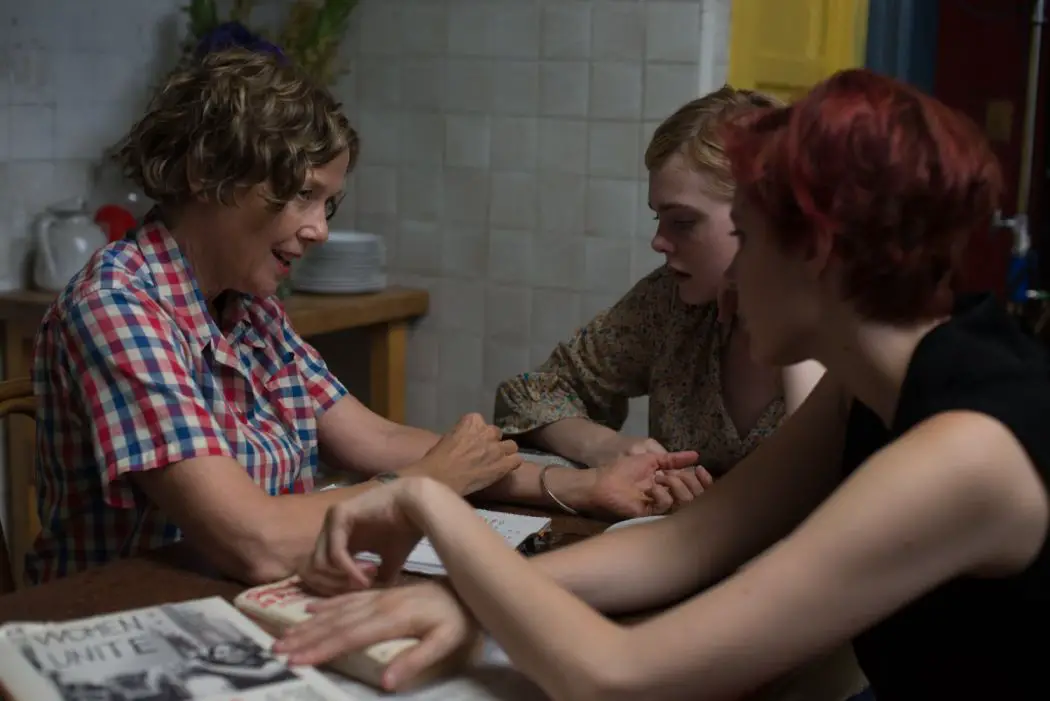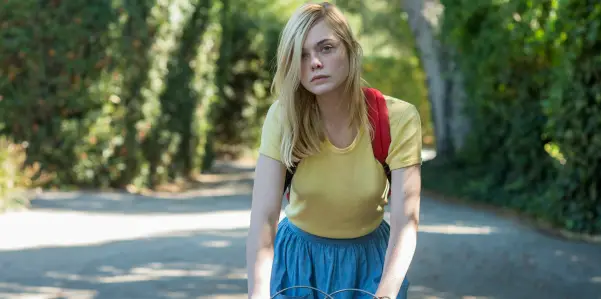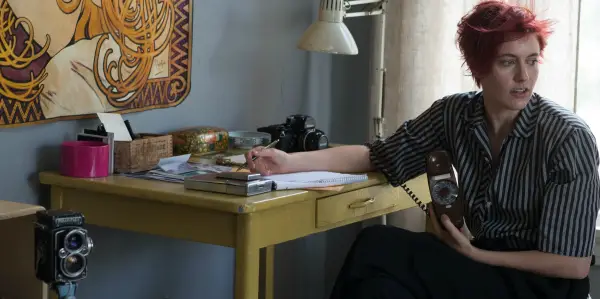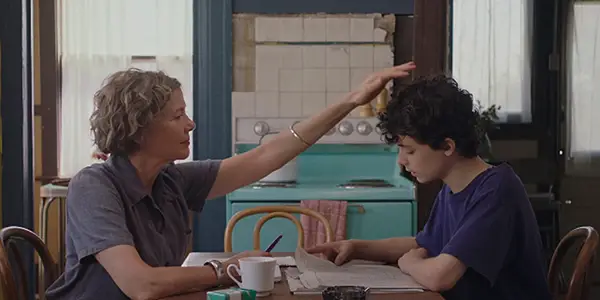20TH CENTURY WOMEN: Annette Bening Shines In Period Character Study

Jim Dixon retired from practicing law not a moment too…
20th Century Women is set in 1979, and though it’s full of period detail, it’s singularly un-nostalgic. It’s also a frequently fascinating portrait of interesting characters, many of whom simply couldn’t exist in the twenty-first century, but that’s both its strength and weakness. Writer/director Mike Mills’ (Beginners) movie is a character portrait in search of a story.
Not just a coming of age story
It would be easy, and inaccurate, to try to cast 20th Century Women as the coming-of-age story of fifteen year old Jamie (Lucas Jade Zumann), but even the title should give you a clue that there’s more going on here than that. Zumann is excellent as an adolescent being drawn, at first reluctantly and increasingly willingly, into a world of women. Two of the titular women are Julie (Elle Fanning), his 17-year-old best friend, who comes over to snuggle in bed but refuses to have sex with him; and Abbie (Greta Gerwig), a twenty-something photographer who’s renting the room upstairs from his single mother, Dorothea (Annette Bening). For reasons that make sense only to her, Dorothea asks these two troubled young women to help her raise Jamie.

In his last movie, Beginners, Mills painted a fictionalized portrait about his father, seen late in his life. Here, he deals with his mother, but at the age of fifty-five. The best thing about 20th Century Women is Annette Bening’s performance as Dorothea, a chain-smoking (although she smokes menthols, because they’re healthier) sort-of free spirit in Birkenstocks, who always speaks her mind but is frequently less patient when others speak theirs. She’s in her mid-fifties, and the new world, its music, its art, its post-Watergate sensibilities, aren’t hers. Dorothea wants to be with it, but perhaps like all middle-aged parents looking at their children’s world, becomes instantly ridiculous when they try too hard to enter it.
Bening is award-worthy
But if Dorothea doesn’t quite get the world of the younger characters, Bening, in an award-worthy performance, gets Dorothea, including her contradictions. It’s a vibrant, even electric performance, and the result is that Dorothea becomes as real as you could want a movie character to be. Good dialogue helps, of course. “Wondering if you’re happy is a great shortcut to being depressed,” she observes. And she may have a point.
Pains and pangs of adolescent sexuality
20th Century Women is bursting at the seams with the pains and pangs of adolescent sexuality. Julie sneaks into Jamie’s room at night to snuggle with him in bed, but steadfastly refuses to let things go beyond innocent cuddling. Julie, incredibly, seems not to notice the inevitable physical effect this would have on a boy this age night after night. If she did not notice and didn’t care, she’d be a tease, even a sadist. Fanning’s take on the character is that she’s precocious, self-absorbed and not always likable, though not sadistic and her obliviousness is difficult to fathom. Caught between girlhood and womanhood, the character shows both confusion and an unnerving awareness of the power her emerging sexuality gives her.

The politics sneak up on you here. Abbie, whom Gerwig deftly portrays as a wounded mixture of vulnerability and alienation, gives Jamie a copy of Our Bodies, Ourselves, and introduces him to the rock club scene of the late seventies as well as the very transitional feminism of the period. And this has its perils for Jamie. When an older boy brags about his success in bed with a girl the night before, Jamie imprudently tells him that without clitoral stimulation she probably wasn’t climaxing, and gets his ass kicked for his trouble.
Politics help set the tone
The politics, feminism and more, help set the tone, which was not optimistic at the time. Post-Vietnam, post-Watergate America was cynical. The flower children were having babies and many of them would grow up to be Republicans. Jimmy Carter’s “Crisis of Confidence” speech is used here to help the tone. The device isn’t subtle, but to be fair, America overwhelmingly elected Ronald Reagan the next year.

Still, Mills’ voice does not resonate from the seventies. He was only thirteen in the year the story takes place, and frankly his dialogue and sensibilities are all modern indie. He gets the technical details right – the hot pants, the halter tops, the Ford Galaxies and Mavericks, the culture war between punk and disco – but he’s a tourist, not a local. Trained as a graphic designer, Mills is also somewhat prone to visual flourishes, such as psychedelic color separation during a road trip and frankly predictable use of black and white period photographs, which amount to little more than gimmickry, and distract the viewer from the larger movie.
Good individual moments but no plot
20th Century Women is full of moments both amusing and moving, but there is virtually no plot. A memoir or biography can, and should, simply adhere to the facts as best they’re known, but this is a fictional movie, and movies do best in three acts. There have been directors, Howard Hawks and Robert Altman come to mind, who favored character study over plot and tried to reflect the sometimes ostensibly shapeless sprawl of life. With skill and discipline that can be accomplished, but it’s quite a different thing from simply not having a narrative spine.
This is just a collection of anecdotes, too often held together by Jamie’s voice-over narration. That narration in fact sometimes leaps into the future to tell us the ultimate fates of the characters, even their deaths. It’s a showy, if uncinematic, technique, which actually unravels the fabric of 20th Century Women, rather than knitting it together. The one other major male character, a burned out handyman (Billy Crudup), who sleeps with Abbie but falls for Dorothea, provides yet one more opportunity for the plot to go somewhere, yet also falls by the same cinematic wayside.
Dorothea’s ramshackle Victorian house, which Crudup is constantly working on, is the setting for much of the action, and actually becomes sort of a character in its own right. One can easily imagine the characters in framed photos on its walls, and that would sum up this often remarkable film: evocative portraits of interesting characters in an evocative setting, but with no story, no story at all.
What do you think? Is 20th Century Women too plotless for its own good?
Does content like this matter to you?
Become a Member and support film journalism. Unlock access to all of Film Inquiry`s great articles. Join a community of like-minded readers who are passionate about cinema - get access to our private members Network, give back to independent filmmakers, and more.
Jim Dixon retired from practicing law not a moment too soon, and now works as a freelance writer and film critic. A lifelong and unrepentant movie geek, he firmly believes that everything you need to know in life you can learn at the movies. He lives in upstate New York.













